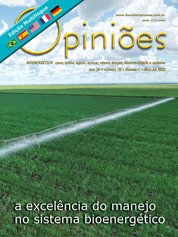Valmir Barbosa
Consultor Sênior da Datagro Alta Performance
OpAA76
Uma visão para a excelência do manejo
Agronomia é ecologia aplicada, pois agricultura é o manejo de um ecossistema para produzir uma determinada espécie. Erros e acertos de um manejo dependem diretamente de previsibilidade e isso depende da estabilidade do sistema. Planejar e preparar para o plantio porque vai chover no dia esperado. A estiagem para a colheita, a friagem, a revoada, a florada, a hora do vento, o dia desta praga, o dia daquela, tudo isso deve estar na agenda do agricultor que deseja acertar o manejo. Quanto mais previsível, maior o acerto, e maior, ainda, a excelência. Quanto mais estável, mais previsível. Quanto mais diversificado, mais estável.
Fazer agricultura é manejar o meio ambiente em favor das espécies que se quer produzir. O agricultor é a quem mais interessa e quem mais ganha com a conservação do solo e da água, com os aumentos da fertilidade do solo, ou melhor, de seu ecossistema. Uma propriedade agrícola não é simplesmente um pedaço de terra, mas, sim, um ecossistema a ser manejado.
Produzir bem, com alta produtividade, já é reconhecido como grande contribuição da agricultura para preservação de outros ecossistemas, porque a alta produtividade possibilita suprir as demandas com menor ocupação de espaços; e assim conviver com diversidade e preservação. O agricultor de boa produtividade consegue reservar uma boa parte de sua fazenda. E é um profissional diferenciado.
Todos sabemos que os sistemas bioenergéticos estão com valor crescente porque substituem petróleo, carvão e gás natural. Esses combustíveis são retirados do subsolo e, na queima, o carbono é lançado na atmosfera. Na atmosfera provocam alterações que resultam em mudança do clima. E é conveniente acreditar nisso porque as consequências esperadas são valiosas demais.
Uma novidade que pode ser observada é o fato de a atmosfera ser finita e sua altura ser apenas de 10 km. Todos os fenômenos climáticos: nuvens, ciclones, correntes, frentes frias, frentes quentes, rios voadores, todos acontecem nessa finíssima camada acima e ao redor da terra. Quando vemos no livro escolar um círculo representando a terra e outro em volta dela escrito atmosfera, esse desenho está errado; pois se o planeta tivesse 10 cm de diâmetro, a atmosfera teria 0,09 milímetro, ou seja, menos de um décimo de milímetro.
Bom lembrar, também, que a evaporação e a condensação da água resultam de combinações de temperatura e pressão muito precisas. Por isso, essas pequenas variações podem causar grandes alterações.
Além disso, os sistemas bioenergéticos têm capacidade de manter uma grande quantidade de carbono não estático mobilizado em seus processos no solo, na biomassa, nos estoques, nos produtos, entre outros.
Nisto está demonstrado o valor do sistema bioenergético: Quanto menor a emissão de carbono, menor demanda de recursos naturais. Quanto mais alinhado à sociedade, maior seu valor de mercado e sua possibilidade de valor econômico; e, portanto, maior sua longevidade no mercado.
O agricultor primitivo apenas suprimia as outras espécies vegetais, fazia o plantio daquela que lhe interessava e contava com os recursos naturais do ambiente e do seu solo. Fazia tudo que estava ao seu alcance para controlar as pragas, os animais, as plantas indesejáveis e, no final, fazer a sua colheita. Aprendeu a conhecer as estações para saber a época de plantar e seguir os calendários. E o restante é história que todos conhecem.
Com o passar de dezenas, centenas e milhares de anos, o agricultor desenvolveu ferramentas e conhecimentos para facilitar seu trabalho, aumentar a produção e garantir a colheita. Essa evolução aconteceu na medida em que o homem foi aumentando seu controle sobre o ambiente. No mesmo dia em que inventou a enxada e a lança para eliminar as outras espécies e afofar a terra, inventou o arado. Aprendeu a escolher as espécies para plantar e a selecionar as sementes.
Aprendeu a conhecer a fertilidade do solo, a adubá-lo; e só depois aprendeu a conservar sua fertilidade. Desenvolveu as máquinas, a química, os adubos, os defensivos e a genética; tudo isso para manejar o ecossistema agrícola, favorecer e proteger a espécie que queria produzir.
O caminho para ser bem sucedido não depende apenas de decisão política ou estratégica do acionista, mas do sistema de manejo adotado ou desenvolvido. Por exemplo, o sistema bioenergético da cana-de-açúcar não seria aceito no mercado atual se não tivesse eliminado a queimada antes da colheita. E sua eliminação aconteceu não por força da lei, mas sim porque foram desenvolvidas soluções viáveis para a produção e colheita sem queima através de pesquisa científica. Em relação a outras questões sem solução, mudanças estão renhidas por falta de criação de mercados e de oportunidades de negócios.
No sistema bioenergético da cana-de-açúcar, atualmente, alguns componentes têm sido marcados por seu forte impacto. A integração com a indústria devido à logística com grandes quantidades de materiais, produtos do campo para indústria e produtos da indústria para o campo, tem criado oportunidades de forte redução de recursos externos. O uso de vinhaça, torta, fuligem e cinzas pode reduzir a zero a aquisição de alguns adubos nas empresas com um pool suficiente. A
introdução de algumas espécies de microrganismos e o condicionamento para sua manutenção pode reduzir total ou parcialmente outros adubos. No controle de pragas, a introdução e manutenção de algumas espécies de organismos podem manter populações de pragas a níveis abaixo do dano econômico; sobretudo se associados à resistência varietal e práticas de manejo cultural. O manejo temporal das operações pode resultar em forte contribuição para a produção anual pela integração com a condição do clima ou pelas fases do ciclo fenológico da cana.
Assim, a excelência do processo e dos resultados continuam dependendo do conhecimento e das ferramentas para o manejo dos fatores materiais e temporais.




